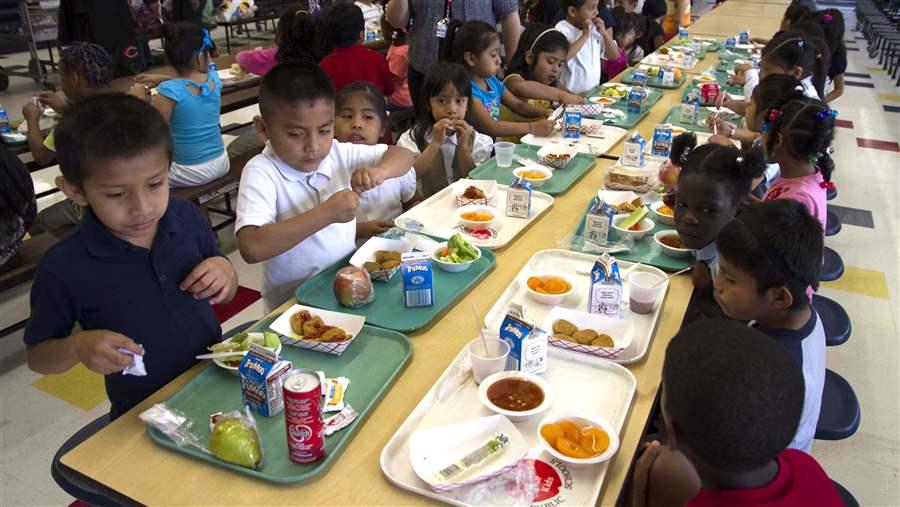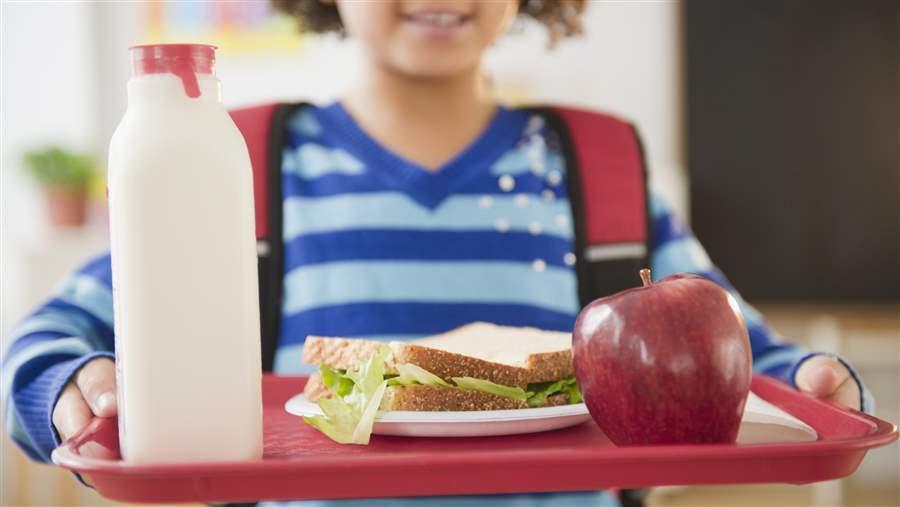As Students Head Back to School, Congress Reviews Meal Programs
House and Senate bills take different approaches to children’s nutrition

The National School Lunch Program funds 5 billion meals a year, helping millions of students get the nutrients and energy they need to learn and grow up healthy.
© The Pew Charitable Trusts
This fall, about 50 million children are returning to U.S. schools, and most of them will participate in the National School Lunch and School Breakfast programs, enjoying healthy, delicious meals in their cafeterias. But they aren’t the only ones with school menus on their minds. Members of Congress are considering legislation that could affect the nutritional quality of school meals and snacks, as well as students’ access to free breakfasts and lunches.
About every five years, Congress reauthorizes the national school meal programs as part of broad child nutrition legislation, and it’s time for lawmakers to fulfill this responsibility again. Earlier this year, committees in the U.S. House of Representatives and Senate approved reauthorization bills that diverge on several important points. Only a few weeks remain in Congress’ 2016 session to resolve these differences, pass a final bill in both chambers, and get President Barack Obama’s signature. If they fall short, it probably will be months before the next Congress and president finish this important law.
Here is a look at where the House and Senate bills stand on issues crucial to school nutrition.
Nutrition standards for school meals
Today, school lunches meet the healthiest nutrition standards in the program’s 70-year history. Thanks to rules updated by the U.S. Department of Agriculture in 2011, every lunch includes servings of fruit and vegetables, a lean protein entree, foods rich in whole grains, and low-fat milk.
That could change if Congress follows the course recommended by the House Education and Workforce Committee, which approved the Improving Child Nutrition and Education Act of 2016 (H.R. 5003) in May. The bill would require that USDA revise its science-based meal guidelines if school administrators report that compliance has increased costs or discouraged student participation. Under this provision, complaints from even a few districts could force USDA to lower nutrition standards nationwide.
The House bill would also allow up to three states to dramatically alter nutrition and eligibility criteria for these programs; they would receive a fixed amount of federal funding—a block grant—for meals, instead of reimbursements based on the number of children served. They also would be able to set more restrictive eligibility guidelines for free and reduced-price meals than the rest of the nation and adopt nutrition standards that are far weaker than USDA’s.
In contrast, the Senate Agriculture Committee’s reauthorization bill, the Improving Child Nutrition Integrity and Access Act of 2016 (S. 3136), would preserve USDA’s authority to establish nutrition standards based on the best science on children’s health and dietary needs. To help the few districts still struggling to navigate the transition to updated meal guidelines, the bill would allow them to occasionally serve products made with less than 50 percent whole grain and would extend until 2019, instead of 2017, the deadline to further reduce the average amount of sodium in meals.
Beyond the lunch line
In July, USDA issued the final rule updating nutrition standards for food and drinks sold in cafeteria a la carte lines, vending machines, and school stores, known as “Smart Snacks” standards. These revisions, the first in more than 30 years, require that all snacks available for purchase on campus be composed primarily of a fruit, a vegetable, protein, dairy, or whole grain; have fewer than 200 calories; and be low in fat, sodium, and sugar.
The House bill would create a large loophole in this rule. Schools could sell any snack food, regardless of its caloric or nutritional content, as long as the item was served as part of a complete meal once during the year. The bill also seeks to repeal nutrition standards for food-based fundraisers held during the school day, which would create unhealthy competition for meal programs and undermine students’ health.
On the other hand, the Senate bill would preserve the Smart Snacks standards, including those for food and drinks sold as part of fundraisers.
Access to healthy foods
Another important difference between the bills is their designation of schools that can take advantage of the Community Eligibility Provision (CEP), which allows meal programs serving high-poverty communities to offer free meals to all students instead of collecting applications for this benefit from each family. Under CEP, if at least 40 percent of a school’s students receive federal food or anti-poverty aid, school leaders can elect to participate in CEP. The House legislation would raise this threshold to 60 percent, stripping about 7,000 schools nationwide of their eligibility. The CEP threshold would not change under the Senate’s bill.
Investing in a healthier next generation
Both the House and Senate reauthorization proposals would prioritize investments in modernizing equipment, to renovate outdated and poorly equipped kitchens and cafeterias by authorizing federal grants to help schools purchase equipment and providing low-interest loans to help pay for more extensive remodeling and purchases.
Six of every 10 students get lunches from their schools, 4 in 10 get snacks, and about 3 in 10 receive breakfasts. The provisions Congress decides to include in the next child nutrition law will make a huge difference, for better or worse, for those students and their peers.
You can help ensure that our children have access to healthy foods by signing up to stay informed about what’s going on in school nutrition.
Jessica Donze Black directs The Pew Charitable Trusts’ child nutrition project.









